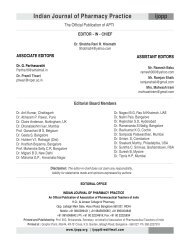Oct-Dec, 2011 - Indian Journal of Pharmacy Practice
Oct-Dec, 2011 - Indian Journal of Pharmacy Practice
Oct-Dec, 2011 - Indian Journal of Pharmacy Practice
- No tags were found...
You also want an ePaper? Increase the reach of your titles
YUMPU automatically turns print PDFs into web optimized ePapers that Google loves.
Satyanarayana V - Evaluation <strong>of</strong> the Impact <strong>of</strong> a Therapeutic Management and Effect <strong>of</strong> Pharmacist Intervention on Children with AsthmaCurrently, asthma affects approximately 15 millionindividuals in the United States. On an annual basis, 5,000deaths, 500,000 hospitalizations, and 2 million emergency9, 10, 11department visits are attributed to asthma . Asthmacontinues to be under – diagnosed and under – treated, itsappropriate management requires correct diagnosis,assessment <strong>of</strong> severity, proper management includingappropriate follow-up, and specialty referral whereappropriate. The guidelines for treatment <strong>of</strong> asthmarecommend greater involvement <strong>of</strong> the patients in the12, 13management <strong>of</strong> their diseases .According to the National Heart, Lung and Blood Institutes(NHLBI) current guidelines, asthma treatment entails amultilevel intervention including appropriatepharmacological therapy, patient education, control <strong>of</strong>asthma triggers, and monitoring <strong>of</strong> asthma severity with13objective measures <strong>of</strong> lung function . Collaborativeapproach between patient and pharmacist may improvepatient medication adherence behavior and therapeuticoutcomes. Role <strong>of</strong> pharmacist as asthma educator isappreciated worldwide in reducing the risk factors and14improving patient knowledge . The role <strong>of</strong> pharmacist inpatient education and evaluation <strong>of</strong> therapy is taking no morerelevance every day. Their knowledge <strong>of</strong> drug therapy makesthem the appropriate pr<strong>of</strong>essional to instruct and educate thepatient on the correct use <strong>of</strong> medications. For many years,pharmacists have been taking an active role not only in theeducation <strong>of</strong> the patient, but also in the monitoring andevaluation <strong>of</strong> therapy, and detecting potential problems (adverse – reactions and interactions, therapy failures, nonadherenceto treatment, duplication <strong>of</strong> therapy, etc.) that15, 16, 17directly affect the quality <strong>of</strong> life <strong>of</strong> the patients .Pharmaceutical care practice is intended to meet a need in thehealth care system that has arisen due to the increase incomplexity <strong>of</strong> drug therapy and the significant level <strong>of</strong> drug –18related morbidity and mortality associated with drug use .Therefore, the introduction <strong>of</strong> pharmaceutical care is requiredin developing countries to aid in the resolution <strong>of</strong> medication– related problems. The existence <strong>of</strong> variations inpharmaceutical care models and practices among countries19were also reported .Medicine use is rational (appropriate, proper, correct) whenpatients receive the appropriate medicines, in doses that meettheir own individual requirements, for an adequate period <strong>of</strong>20time, and at the lowest cost both to them and the community .Irrational (inappropriate, improper, incorrect) use <strong>of</strong>medicines is when one or more <strong>of</strong> these conditions are notmet. Worldwide, it is estimated that over half <strong>of</strong> all medicines21, 22are prescribed, dispensed or sold inappropriately .Moreover, it has been estimated that half <strong>of</strong> all patients fail to23take their medication as prescribed or dispensed . Irrationaluse may take many different forms, for example,polypharmacy, over-use <strong>of</strong> antibiotics and injections, failureto prescribe in accordance with clinical guidelines andinappropriate self-medication. However, despite the globalproblem <strong>of</strong> inappropriate use, few countries are monitoringmedicines use or taking sufficient action to correct the24situation . Thus the purpose <strong>of</strong> the study is to conduct adetailed prospective study about to evaluate the impact <strong>of</strong> atherapeutic management and effect <strong>of</strong> pharmacistintervention on children with asthma. The present study wasconducted with the following objectives:-1. To study the current line <strong>of</strong> therapeutic managementfollowed in the department <strong>of</strong> pediatrics in the Gandhigeneral hospital, Hyderabad, Pediatric unit has five unitsdistributed into two wards, each unit consisting <strong>of</strong> 30beds total <strong>of</strong> 150 beds, providing specialized health careservice to all strata <strong>of</strong> people in A.P.2. To compare this with standard treatment guidelines.3. To find the impact <strong>of</strong> counseling in patients withbronchial asthma and their parents.4. To educate the patient and parents regarding the healthcondition and importance <strong>of</strong> life style modification.5. To promote rational use <strong>of</strong> drugs.MATERIAL AND METHODSStudy Design: This study was a prospective, observational,interventional study consisting <strong>of</strong> 100 patients with bronchialasthma. Following prescription analysis patients areevaluated about therapeutic management <strong>of</strong> asthma inchildren's.Study Site: This study was conducted in the Gandhi Hospital,paediatric unit has five units distributed in two wards, eachunit consisting <strong>of</strong> 30 beds total <strong>of</strong> 150 beds, providingspecialized health care service to all strata <strong>of</strong> people in anAndhra Pradesh.Duration: This study was conducted for a period <strong>of</strong> 6 monthsststfrom 1 November 2010 to 31 April <strong>2011</strong>Study Criteria:Ø Inclusion Criteria:· Patients with history <strong>of</strong> bronchial asthma in the age group<strong>of</strong> 1 to 12 yrs.· Patients and their parents willing to give their informedconsent to participate in the study<strong>Indian</strong> <strong>Journal</strong> <strong>of</strong> <strong>Pharmacy</strong> <strong>Practice</strong> Volume 4 Issue 4 <strong>Oct</strong> - <strong>Dec</strong>, <strong>2011</strong> 40
















